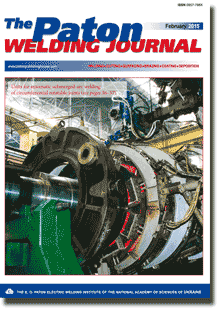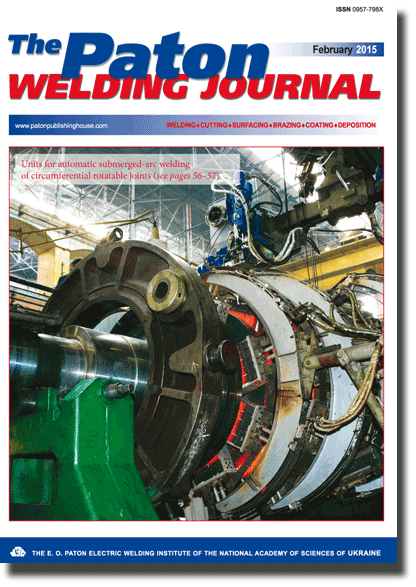| 2015 №02 (05) |
DOI of Article 10.15407/tpwj2015.02.06 |
2015 №02 (07) |

The Paton Welding Journal, 2015, #2, 30-33 pages
THERMODYNAMIC PROPERTIES OF MELTS OF CaO2-SiO2 SYSTEM
I.A. Goncharov1, V.I. Galinich1, D.D. Mishchenko1 And V.S. Sudavtsova2
1E.O. Paton Electric Welding Institute, NASU. 11 Bozhenko Str., 03680, Kiev, Ukraine. E-mail: office@paton.kiev.ua
2I.M. Frantsevich Institute of Problems of Materials Science, NANU. 3 Krzhizhanovsky Str., 03680, Kiev, Ukraine
Abstract
Given is the analysis of literature data on the phase equilibriums of constitutional diagrams and thermodynamic properties of alloys of calcium oxide-silicon oxide system. It was found that data on activities of components of these melts are characterized by high scattering. The activity of calcium oxide and silicon oxide in eutectic melt were calculated from coordinates of liquidus line of constitutional diagram of calcium oxide-silicon oxide system. It was established that the calcium activity at silicon concentration of more than 0.2 shows the negative deviations from perfect solutions and correlates with experimentally established data. Activity of silicon oxide at silicon concentration of less than 0.5 in eutectic melt shows the large negative deviations from perfect solutions and correlates with experimentally established ones. At concentration of silicon oxides of 0.34 the activity of silicon oxide is 0.03, i.e. it is by one order lower than its concentration in solution that is explained by the formation of thermodynamically stable two-calcium silicate. At 725 °C a-g transformation occurs in this compound, accompanied by change in volume. Therefore, it is recommended to keep such ratio of calcium and silicon oxides in the composition of fluxes for electroslag remelting of hollow ingots and welding, at which two-calcium silicate will be formed in the melt. These fluxes will have a poor interaction with molten metal and provide the excellent removal of solidified slag from the surface of ingot and weld metal. 17 Ref., 1 Table, 3 Figures.
Keywords: calcium oxide, silicon oxide, constitutional diagram, activity of melt components, fluxes for welding and electroslag remelting
Received: 30.10.14
Published: 01.04.15
References
1. Goncharov, I.A., Galinich, V.I., Mishchenko, D.D. et al. (2014) Prediction of thermodynamical properties of melts of CaO-Al2O3 system. The Paton Welding J., 4, 26-29. https://doi.org/10.15407/tpwj2014.04.04
2. Sudavtsova, V.S., Kiriakov, V.M., Podgaetsky, V.V. (1988) Thermodynamical properties of CaO-SiO2 melts. Avtomatich. Svarka, 7, 35-37.
3. Richardson, F.D., Jeffes, H.E., Withers, G. (1950) Thermodynamic data on materials which are important for steel production. J. Iron and Steel Inst., 166(2), 213-234.
4. Fincham, C.J.B., Richardson, F.D. (1954) Behaviour of sulphur in silicate and aluminate melts. Proc. Roy. Soc. Sec. A, 233(1), 40-62. https://doi.org/10.1098/rspa.1954.0099
5. Fullton, J.C., Chipman, J. (1954) Slag-metal-graphite reaction and silica activity in limestone-alumina-silicate slags. Transact. of Amer. Inst. Min. Met. Eng., 200(9), 1136-1146.
6. Murray, P., White, K. (1948) SiO2 activities in molten CaO-SiO2 system. Disc. Faraday Soc., 4(3), 287-296. https://doi.org/10.1039/df9480400287
7. Chang, L.C., Derge, G. (1947) Sampling and analysis in determination of hydrogen in steels. Transact. of Amer. Inst. Min. Met. Eng., 172(1), 90-120.
8. Sanbongi, K., Othani, M. (1952) Measurement of the equilibrium among silicon in molten iron, CaO-SiO2 binary slag and H2-H2O mixed gas. Sci. Rep. Tohoku Univ., 4(1), 59-71.
9. Carter, P.T., Macfarlane, T.G. (1957) Thermodynamics of slag systems. Pt2: Thermodynamic properties of CaO-SiO2 slags. J. Iron and Steel Inst., 173(1), 62-66.
10. Stolyarova, V.L., Shornikov, S.I., Ivanov, G.G. et al. (1991) High-temperature mass spectrometric study of thermodynamic properties of the CaO-SiO2 system. J. Electrochem. Soc., 138(12), 3710-3714. https://doi.org/10.1149/1.2085485
11. Pelton, A.D., Blander, M. (1986) Thermodynamic analysis of liquid solutions by a modified quasichemical approach - Application to silicate slag. Met. Transact. B, 7, 805-815. https://doi.org/10.1007/BF02657144
12. Hillert, M., Sundman, Bo., Wang, X. (1990) An assessment on the CaO-SiO2. Met. Transact. B, 4, 303-312. https://doi.org/10.1007/BF02664198
13. Ayed, F., Sorrentino, F., Castanet, R. (1994) Determination par calorimetrie de dissolution des enthalpies de formation de quelques silicates, aluminates et alumino-silicates de calcium. J. Thermal Anal., 41, 755-766. https://doi.org/10.1007/BF02547157
14. Sryvalin, I.T., Esin, O.A. (1970) Application of quasichemical theory for calculation of thermodynamic properties of alloys of silicate melts. In: Physical chemistry of molten slags, 83-94. Kiev: Naukova Dumka.
15. Sudavtsova, V.S., Makara, V.A., Kudin, V.G. (2005) Thermodynamics of metallurgical and welding melts. Pt3: Alloys on the base of nickel and tin, methods of modeling and prediction of thermodynamic properties. Kyiv: Logos.
16.Park, J.H. (2007) Solidification structure of CaO-SiO2-MgO-Al2O3(-CaF2) systems and computational phase equilibria: Crystallization of MgAl2O4 spinel. Computer Coupling of Phase Diagrams and Thermochemistry, 31, 428-437. https://doi.org/10.1016/j.calphad.2007.05.005
17. (1995) Slag atlas. 2nd ed. Duesseldorf: Verlag.
Suggested Citation
I.A. Goncharov, V.I. Galinich, D.D. Mishchenko And V.S. Sudavtsova (2015) Thermodynamic properties of melts of CaO2-SiO2 system. The Paton Welding J., 02, 30-33.The cost of subscription/purchase order journals or individual articles
| Journal/Currency | Annual Set | 1 issue printed |
1 issue |
one article |
| TPWJ/USD | 384 $ | 32 $ | 26 $ | 13 $ |
| TPWJ/EUR | 348 € | 29 € | 24 € | 12 € |
| TPWJ/UAH | 7200 UAH | 600 UAH | 600 UAH | 280 UAH |
| AS/UAH | 1800 UAH | 300 UAH | 300 UAH | 150 UAH |
| AS/USD | 192 $ | 32 $ | 26 $ | 13 $ |
| AS/EUR | 180 € | 30 € | 25 € | 12 € |
| SEM/UAH | 1200 UAH | 300 UAH | 300 UAH | 150 UAH |
| SEM/USD | 128 $ | 32 $ | 26 $ | 13 $ |
| SEM/EUR | 120 € | 30 € | 25 € | 12 € |
| TDNK/UAH | 1200 UAH | 300 UAH | 300 UAH | 150 UAH |
| TDNK/USD | 128 $ | 32 $ | 26 $ | 13 $ |
| TDNK/EUR | 120 € | 30 € | 25 € | 15 € |
AS = «Automatic Welding» - 6 issues per year;
TPWJ = «PATON WELDING JOURNAL» - 12 issues per year;
SEM = «Electrometallurgy Today» - 4 issues per year;
TDNK = «Technical Diagnostics and Non-Destructive Testing» - 4 issues per year.


